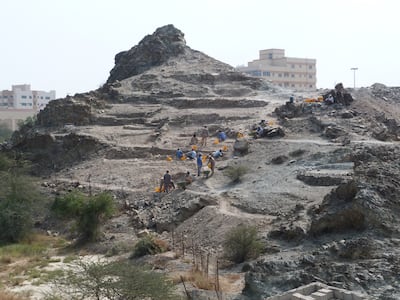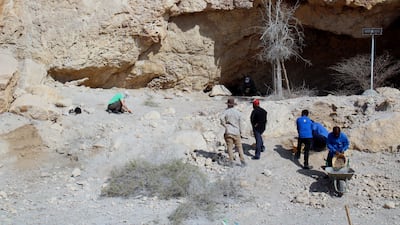Archaeologists have uncovered significant evidence of prehistoric settlements in Fujairah, challenging previous habitation timelines by thousands of years.
The findings indicate that the Jabal Kaf Addor rock shelter in the Al Habhab region was occupied from 13,000 years ago.
Stone tools, animal bones and fireplaces found at the site showed human settlers occupied it several times during that period.
It was initially believed that South-east Arabia was uninhabited from about 38,000 years ago until 7,000 years ago.
University of Jena
Dr Knut Bretzke, from the University of Jena in Germany, who supervised the excavations, said the findings were "very surprising".
"I have worked in South-east Arabia for about two decades now and have excavated a number of sites in the UAE and Oman, but I have never come across evidence for human settlement in the region from about 13,000 years ago so far," he said.
"It has always been argued that humans left the region latest during the Last Glacial Maximum, a period of hyper-arid conditions in Arabia between about 26,000 and 20,000 years ago.
"Recolonisation was then thought to have to co-occurred with the onset of the Holocene wet phase about 12,000 years ago.
"The archaeological records have shown this with the occurrence of small arrowheads called Fasad points ... that were dated to about 10,000 years ago."
Dr Bretzke said the findings at Jabal Kaf Addor filled in "a significant gap" and "forces [the] re-evaluation of ideas about hunter-gatherer settlements" in South-east Arabia.
"This new evidence now suggests a rather continuous occupation and a reduced dependency of human settlement on changing precipitation," he said.
"Local hydrological and geomorphological conditions may have had a greater impact on the survival chances of prehistoric hunter-gatherers than previously thought."
The researchers included teams from Fujairah's Department of Tourism and Antiquities, Germany's University of Jena and Oxford Brookes University in the UK.
Researchers believe the high-quality lithic raw material found in Jabal's limestone and access to a variety of landscapes, including the western foothills of the Al Hajar Mountains and wadi channels, would have attracted the early settlers.
"Our research not only highlights the rich prehistoric heritage of Fujairah but also underscores the resilience and adaptability of early human groups to varying climatic conditions," said Prof Adrian Parker, a palaeo-environmental specialist from Oxford Brookes University who also took part in the project.
More than 30 sites with significant geological characteristics were identified, state news agency Wam reported.
"These discoveries not only enhance our understanding of the history of our region but also places Fujairah at the forefront of major sites for archaeological and geological research, opening new horizons for scientific co-operation and cultural tourism in the emirate," added Ali Qasim, director of Fujairah Natural Resources Corporation.
Recently, Sheikh Mohammed bin Hamad Al Sharqi, Fujairah's Crown Prince, accepted the proposal for more excavations at Jabal Kaf Addor and additional surveys in its vicinity.
Archaeological legacy
Fujairah is no stranger to archaeological discoveries. A study was released last year explaining how Masafi, a town in the foothills of the Hajar Mountains, was home to a settlement where people grew crops, reared animals, expertly used raw materials and traded with other villages.

Prof Parker said the rock shelter at Jabal Kaf Addor was discovered in the 1990s and had come close to being quarried away before it was protected.
Often rock shelters such as the one where the excavations took place have only stone tools but this one had bone and charcoal, too.
"[There are] bones in reasonably good preservation and charcoal and layers of human occupation," he said. "The lowest level we’ve [worked on] came out about 13,300 to 13,000 years old."
This age came from radiocarbon dating, which analyses the quantities of a particular form of carbon, called carbon 14, that remains in what was once living material.
"People were occupying, and hunting and processing animals, and gathering material they could burn as fuel, so fire hearths were on the site," Prof Parker said.
He said it had been thought the area was "too arid, too dry to support humans" at about 13,000 years ago, so the evidence for human habitation from that time comes as a surprise as it predates other evidence of occupation by about 2,500 years.
"In Arabia it didn’t get wet until 10,500 to 10,000 years ago, but we’ve got occupation … before then, which is interesting," Prof Parker said.
"The question is, where did the people come from. Was it in earlier population or a new wave of people? Who are they and where did they come from? We don’t know. It’s just remarkable there are people there at that time. We don’t really know what the climate was like at the time.
"The big sand dunes were forming around then. You have this phase of massive sand dune deposition, so people previously thought it was too dry. They must have had access to resources and to water and food."
Work is now being carried out to identify the bones found, while additional analysis is also being carried out on other material.
The researchers, who carried out their work on site in late 2022, are hoping to publish their findings in an archaeological journal and have permission to undertake further excavations.
From about 10,500 years ago the area became gradually wetter over thousands of years as a result of a change in the balance between two climatic systems.
"The region is positioned at the interface between two of the Earth’s climatic systems, namely the mid-latitude Westerlies, which today bring winter rains and the hot summer Shamal winds, and the Indian Ocean summer monsoon," Prof Parker said.
"Today the monsoon is weak, but at various times has increased in intensity across the region. About 13,000 years ago, it was previously thought that the Westerlies were intensified, driving more arid conditions.
"Globally, the onset of the current interglacial, called the Holocene, started around 11,700 years ago. This saw the collapse of the Northern Hemisphere ice sheets and the onset of warmer global temperatures."
Prof Parker said evidence from the region shows the onset of much wetter conditions from about 10,500 years ago with the growth in Oman of cave speleothems, such as stalactites and stalagmites, and the development of lakes and wetlands and active wadis in the UAE that flowed into the Gulf from the Hajar mountains.
By 7,000 years ago the region was at its wettest with Neolithic hunter-herders occupying the areas and milestones such as the domestication of dates were achieved.


